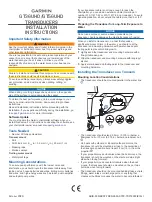
7
P R O B E CA R E A N D M A I NT E NA N C E
Since your pH electrode is susceptible to dirt and contamination, clean it every one
to three months depending on the extent and condition of use.
NOTE: For specialty electrode care, consult the instruction manual included with
your electrode.
pH electrode storage
For best results, always keep the pH bulb wet. Use the protective electrode storage
bottle or rubber cap filled with electrode storage solution to store your electrode.
Also, you can store in a pH 4 buffer with 1/100 part of saturated KCl. Other pH
buffers are OK for storage, but NEVER use distilled water for storage.
After measuring
1. Rinse the pH electrode and reference junction in de-ionized water.
2. Store the electrode as recommended above in “pH electrode storage,” or
as recommended by the manufacturer.
3. Prior to next use, rinse the liquid junction with de-ionized water and tap dry
– never wipe electrode.
NOTE: If this does not restore electrode to normal response, see “Reactivating the
pH electrode” section below.
pH electrode cleaning
•
Salt deposits
: Dissolve the deposits by immersing the electrode in tap
water for ten to fifteen minutes. Then thoroughly rinse with distilled water.
•
Oil/Grease film
: wash electrode pH bulb gently in some detergent and
water. Rinse electrode tip with distilled water or use a general purpose
electrode cleaner (see ordering information).
•
Clogged reference junction
: Heat a diluted KCl solution to 60 to 80
°
C.
Place the sensing part of the electrode into the heated solution for about
10 minutes. Allow the electrode to cool in some unheated KCl solution.
•
Protein deposits
: Prepare a 1% pepsin solution in 0.1 M of HCl. Set the
electrode in the solution for five to ten minutes. Rinse the electrode with
distilled water.
Summary of Contents for ?lpha-pH500
Page 1: ...Alpha pH 500 2 Wire Transmitter pH ORP...
Page 9: ...3 INSTALLATION 3 1 Wall Mount...
Page 28: ...10 TECHNICAL DIMENSIONS...









































